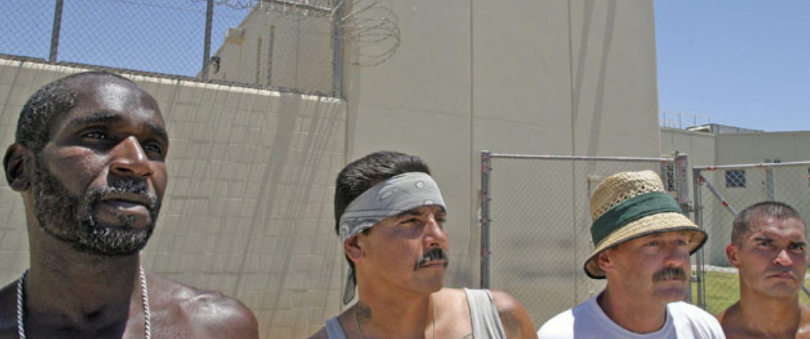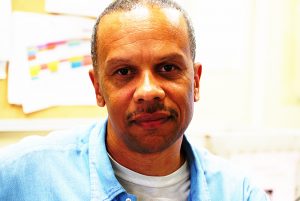Editor’s Note:
This essay, by James King is one of a series of essays WitnessLA is publishing that are written through the FirstWatch project at San Quentin State Prison. With their writing, the journalists, who are also San Quentin inmates, aim to, as they put it, explore “the connections, challenges, and intimacies between self, society, and incarceration.”
(You can read some earlier essays in the series here and here.)
In this essay, author King examines his first encounter with the strange and complex system of racial “politics” that has embedded itself in California’s prisons for decades, and which produces its own special kind of collateral damage.
Watch for Part 2 of King’s writing on the subject, coming soon.
Racing Backward
by James King
I will never forget the first time I was exposed to racial politics in California state prisons (politics is the term incarcerated people in California use to refer to our unwritten social rules.) It was the morning after my arrest. The day before I’d spent about ten hours in a small holding pen with between ten and fifteen others waiting to be photographed, fingerprinted, and assigned to a cell.
When I finally made it to the cell, it was after lockdown. I stayed awake long enough to greet my cellmate, spread a sheet over the bunk, and make a makeshift pillow out of my shoes and a wool blanket. Then I slept for about twelve hours.
I woke up, grabbed a bar of soap, a towel, slipped on my shower shoes, and headed down the tier to one of the two showers in the 32 man housing unit.
Before I could get there, I was stopped by a tall, slender Mexican. “You can’t use that shower. Blacks use the other one.”
Emotion poured through my body. Was I being challenged? Surely this guy wasn’t telling me that the showers were racially segregated. The shower was empty just a few feet away from us. Thought after thought tripped over each other in my brain as I surveyed the dayroom. Only he and I were out. I could push past him. He had to be trying to test me to see how I would respond. If I didn’t pass this test, would it somehow signal to the rest of the unit that I was easy prey? And one final thought crept in almost unnoticed if it were not for its foreignness. What would the other black men in the unit think?
I retreated back to my cell to ask my cellmate what he thought I should do. Casually, he confirmed the other guy’s statement. “That shower is for whites and Mexicans only. We have the downstairs shower and those four tables are ours,” he said pointing to the ones closest to the door. “Oh, and that phone on the left is ours.”
What the hell? Didn’t we win this fight in the sixties? Didn’t people die so that we could go anywhere, use any phone, drink from any water fountain? My cellie just shrugged.
Since that first encounter, I’ve learned that racial segregation in California prisons is every bit as unquestioned as count time, as ubiquitous as handcuffs, with rules as unique and explicit as prison handball. Every race to its own in the cell, the dayroom, the yard. Well into the mid-2000s, prison administrations perpetuated the divisions by writing and enforcing policies that segregated prison yards by race.
I can’t tell you how many people from other races I’ve spoken to over the years who I considered reasonable, enlightened, and potentially even friends, who sincerely tried to explain to me the benefits of our racial segregation system. Racial politics prevent race riots, even though we still have them, there is no doubt we’d have more if not for the rules. Blacks typically outnumber other races on most yards, and if there were no rules in place blacks would probably monopolize every aspect of prison life. Blacks are loud, pushy, aggressive. Since I personally am not like that, surely I understand.
Meanwhile, black men I speak to about this topic tend to see the status quo as just another part of the prison experience that it is best if they tolerate, even if it is vaguely dehumanizing.
It’s frustrating to see people, who often come from marginalized communities, further divide themselves along racial lines. In writing this, and thinking about it, I wonder if the systemically racist policies are causing incarcerated people here to internalize these anachronistic segregationist views, or if there is no correlation at all. After all, the systems which are potentially influencing people here were created by other people who also hold these beliefs about the validity of racial division. Meanwhile, it’s disheartening to see internal racial politics enforce policies which strengthen the administration’s ability to disenfranchise over a hundred thousand people in this state alone.
About a year after I arrived in prison, the court system ruled that California’s racial segregation policies were unconstitutional, so theoretically, California prisons are now desegregated. There are no written policies supporting racial politics now, but, on the ground, not a thing has changed.
We remain separate, yet unequal. Only seen through the prism of race, and the stereotypes that are used to characterize us. When I think about it more deeply, I realize the segregation I experience in here is merely a more explicit form of something I’ve experienced my entire life. From the all black churches my grandmother and I attended, to the cafeteria at my high school, my environment has been segregated in ways large and small. Why would I expect something different in here?
Author James King is a contributing writer for Re:vision, where this essay first appeared. Some of his influences are James Baldwin, Angela Davis, his hometown of Ferguson, MO, and the belief that all oppression must be eradicated. King says he writes to introduce marginalized perspectives, and he writes to feel whole.
Re:vision, where this essay was first published, is a series of personal blogs written through the FirstWatch project at San Quentin State Prison. Through traditional postal mail letters, the journalists delve into a list of topics, looking at them through a lens that includes the complex interweave of relationships between self, society, and incarceration, also opening themselves up to responding to perceptions and questions posed by the public.
FirstWatch is a media project started by a group of men incarcerated at San Quentin, in collaboration with Re:store Justice, which works in partnership with incarcerated people, survivors of crime, district attorneys, and the community. Their mission is to re-imagine and reform our criminal justice system to be one of true inclusion and justice.



Prison sounds awful.
If only there were a way to not be imprisoned…
The same scenario applies to the largest jail sysem in the free world which is Los Angeles County. Regarding the encounter in prison, better a verbal heads-up than a shank.
A system of, by, and for prisoners. Enforced by prisoners, invented by prisoners. Of course we get the obligatory all purpose explanation blaming “systemic racism”. A duel purpose explanation, letting the (present) prisoners of color off the hook while managing to blame the (absent) white patriarchy at the same time. It’s a religion, and witness la is a true believer, preaching dogma to the faithful.